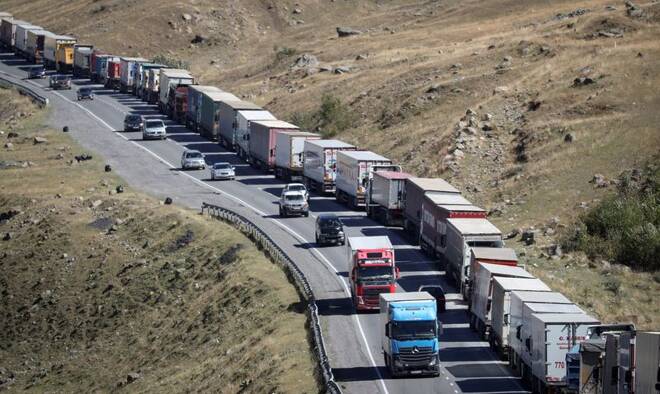Advertisement
Advertisement
Where have Russians been fleeing to since mobilisation began?
By:
BERLIN (Reuters) - Russians have piled across the border to neighbouring states since President Vladimir Putin announced a partial mobilisation on Sept. 21 for the war in Ukraine.
BERLIN (Reuters) – Russians have piled across the border to neighbouring states since President Vladimir Putin announced a partial mobilisation on Sept. 21 for the war in Ukraine.
Here is a guide on how many people have crossed and how countries are reacting:
How many have fled russia since mobilisation was announced?
Getting precise totals is difficult but the number of Russians who have left could run into hundreds of thousands, based on media reports and figures released by neighbouring states. Figures are not usually broken down, so can include men facing the draft, family members and other travellers.
The independent Novaya Gazeta Europe reported on Sept. 26 that 261,000 men had left since the mobilisation was declared, citing a Kremlin source. The report could be independently verified.
Russia has denied some reports in Russian media saying 700,000 Russians had fled the country since the announcement.
On Oct. 4, Forbes Russia reported that the number of people who have left the country since Putin ordered the draft could be as high as 700,000, citing a Kremlin source.
“I don’t have exact figures, but of course they are far from what’s being claimed there,” Kremlin spokesman Dmitry Peskov said.
Flight ticketing data has pointed to a surge of people leaving. The number of one-way tickets sold from Russia rose 27% from Sept. 21 to Sept. 27 compared with the week prior, according to Spain-based ForwardKeys, which analyses booking reservations.
Russian Defence Minister Sergei Shoigu announced that Russia planned to enlist 300,000 men and, on Oct. 4, said more than 200,000 people had been drafted so far.
Where are most of them going to?
Some are heading to Kazakhstan, which shares the world’s second-longest land border with Russia. Russians can enter without a passport or a visa.
The Kazakh interior minister said on Oct. 3 that more than 200,000 Russians had entered since Sept. 21, while about 147,000 left in the same period, although their final destination was not clear.
The interior ministry of Georgia, where Russians can also enter without a visa, said 68,887 Russians had arrived from Sept. 21 to 29, while 45,624 had left.
For both countries, it was unclear how many of the Russians who left had travelled to third countries.
ForwardKeys’ air travel booking data reported a triple-digit increase for the week ended Sept. 27 in one-way tickets from Russia to Tbilisi, Almaty, Istanbul, Tel Aviv and Dubai.
Turkey, a popular tourist destination for Russians and others, reported a rise in Russian arrivals and flights since mobilisation was announced. One man told Reuters he flew to Istanbul airport the next day partly to avoid conscription.
Some 3 million arrived in Turkey from Russia this year until the end of August, up 22% from last year, official data showed.
Many Russians have also been heading to Europe.
How many get to the eu or other european countries?
The European Union saw a surge in arrivals after Putin’s announcement. Some 66,000 Russian citizens entered the bloc from Sept. 19 to 25, a 30% rise from the previous week, data from the bloc’s border agency Frontex showed.
The number fell to 53,000 in the week starting Sept. 26, Frontex said, citing a stricter EU visa policy and Russian measures to keep military-age men from leaving.
Most Russians entering the EU already had residence permits or visas, while others had dual citizenship, Frontex said.
Finland, which has a 1,300-km (800-mile) border with Russia, has been the main point of arrival in the EU. Finnish data showed the number of Russian tourists arriving via four southern border crossings doubled in the days after Sept. 21.
From Sept. 21 to Oct. 5, 59,975 Russians arrived in Finland through the four checkpoints, with many leaving to other European countries, while 36,116 Russians went home, Finnish border guard authority data showed on Oct. 5.
How are european countries reacting?
Estonia, Latvia, Lithuania and Poland began turning away Russians holding tourist visas issued by any of the EU’s Schengen states on Sept. 19. Finland followed suit on Sept. 30.
Norway’s Arctic border with Russia is the last direct route into Europe open to Russian Schengen tourist visa holders. Norway’s justice minister said on Sept. 30 the government could ban further arrivals from Russia at short notice if necessary.
Since mobilisation began, German embassies in Armenia, Kazakhstan, Georgia, Kazakhstan and Belarus have seen a surge in enquiries from Russian citizens seeking to travel to Germany and the EU.
An interior ministry spokesperson told Reuters the German constitution enshrined the right to political asylum but said: “Due to this case-by-case examination and the severely limited possibilities to travel from Russia to Germany, we assume that there are only a few cases.”
A French minister said France would also be selective on who was allowed to remain in the country, taking into account a person’s situation and the security risk.
“We will make sure dissident journalists, people who fight the regime, artists and students can still come here,” Junior Minister for European Affairs Laurence Boone said on Oct. 5.
(Reporting by Doyinsola Oladipo in New York, Caleb Davis in Gdansk, Alexander Ratz in Berlin, Joanna Plucinska, Olzhas Auyezov, Jake Cordell, Terje Solsvik, Essi Lehto, Geert De Clercq, Jonathan Spicer; Writing by Rachel More and Madeline Chambers; Editing by Edmund Blair and Alex Richardson)
About the Author
Reuterscontributor
Reuters, the news and media division of Thomson Reuters, is the world’s largest international multimedia news provider reaching more than one billion people every day. Reuters provides trusted business, financial, national, and international news to professionals via Thomson Reuters desktops, the world's media organizations, and directly to consumers at Reuters.com and via Reuters TV. Learn more about Thomson Reuters products:
Advertisement
